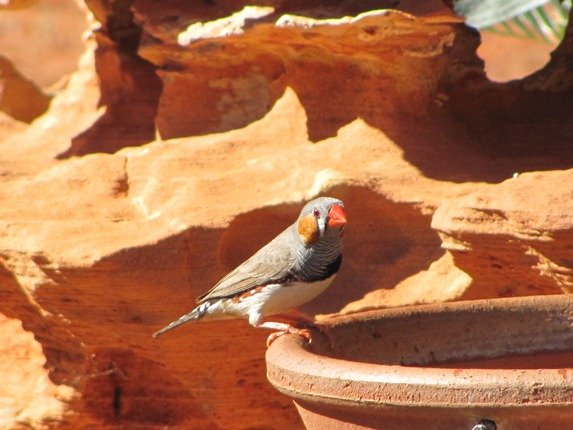
A new research project using Zebra Finches in semi-wild conditions indicates that for some bird populations a certain aspect of climate change may have a negative effect on the viability of populations by causing increased mortality in a subtle but significant way. The study looks at changes in the range of daily temperature variability. This has been looked at in other studies for ectotherms (the most obvious sorts of animals to be affected since they get their heat from ambient conditions) and elderly humans. This is the first study of this kind on birds, or that would relate directly to wild endotherms (the elderly humans do not live in the wild!).
DTR is the Daily Temperature range. This is the range of maximum and minimum temperatures in a given day. DTR is known to change, to either increase or decrease, with climate change (global warming) so understanding the effects of a shifting DTR on wild populations of birds is critically important.
Even when the average daily temperature is unchanged, it is known that certain animals, mainly ectotherms (like reptiles) have higher mortality rates when DTR is large. DTR has not been carefully studies in birds, which are endotherms, until now.
In this study, three variables were considered. The main focus was change in DTR. The other two variables are brought in as stress-causing variables that mimic natural variables that strongly affet bird survival. The first is brood size. Larger brood sizes may seem like a good idea from a Darwinian point of view, because this would mean more offspring. But there is no free lunch, especially for birds. As brood size increases beyond some limit (which may depend on other factors) the quality of individual offspring decreases, and their survivorship may go down. Birds are famous for manipulating brood size (in some species) in response to likely availability of food, and this ability has been at the center of major debates in biology over the level at which natural selection works. Are gulls, for instance, reducing their reproductive output in some years so all the gulls have a chance to eat (group selection) or are they reacting to environmental cues to maximize survival of their own offspring (standard selfish natural section)? The answer to that question has been shown fairly conclusively to be the latter. In any event, brood size matters, so in the experiment I’m talking about here, it was manipulated by the researchers.
The other contextual variable was foraging difficulty. The experimenters changed the difficulty of foraging for different groups of birds, so some birds would have to spend more energy on foraging than others. Bird age and other factors were also considered.
The birds used in this study were Zebra Finches reared and housed at the University of Groningen in the Netherlands. The lived in outside aviaries with about 15-30 birds of each sex living in them, in a total of eight aviaries. The experiment was run over several years with several hundred birds.
Most importantly, and the thing that makes this experiment unique and especially important, is that the relationship between the key variables, especially DTR, were observed on a daily basis, rather than averaging out over time, so specific effects of more extreme cold or heat, or just, more extreme conditions, could be related to bird deaths.
The results are fairly complicated, and a little counter-intuitive. I would have predicted that bird mortality would go up the most when foraging costs were high and temperatures were low, because birds spend energy on both foraging and keeping warm. Perhaps that is in fact what happens in colder environments (in other words, I’m sticking to my story for now, until I see more studies done in colder environments). From the abstract:
… we show that mortality rate increases almost two-fold per 1°C increase in diurnal temperature range (DTR). Interestingly, the DTR effect differed between two groups with low versus high experimentally manipulated foraging costs, reflecting a typical laboratory ‘easy’ foraging environment and a ‘hard’ semi-natural environment respectively. DTR increased mortality on days with low minimum temperature in the easy foraging environment, but on days with high minimum temperature in the semi-natural environment. Thus, in a natural environment DTR effects will become increasingly important in a warming world … These effects were particularly apparent at young ages … the effect of DTR on mortality is delayed up to three months, while effects of minimum temperature occurred within a week. These results show that daily temperature variability can substantially impact the population viability of endothermic species.
So increasing DTR increases mortality. This is a phenomenon seen in some regions, with global warming, especially in some tropical and subtropical areas. The effects of DTR on mortality was, as expected (by me) high with low minimum temperature but only when foraging was made easy. When foraging was made hard, the high minimum temperature increased mortality. It is not perfectly clear why, but the researchers speculate that heat stress is the cause. Additional muscle activity heats up the animal, and it has to cool down (as an endotherm) but this is harder when it is already warmer, or when cool conditions can’t be exploited to facilitate that cooling. Heat stress can, in turn, cause immune system problems, damage to DNA, organ failure, and of course, just plain death.
____________________________
Photograph of Zebra Finch by bird blogger Clare M, and is cribbed from the 10,000 Birds Gallery.
Briga, Michael and Simon Verhulst. 2015. Large diurnal temperature range increases bird sensitivity to climate change. Scientific Reports. Original document available here.













thanks, Greg.
A blog that’s both educative and interesting,topic of global warming and bird mortality is really good. I am very happy that I have found this during my search.
Thanks for sharing with us.